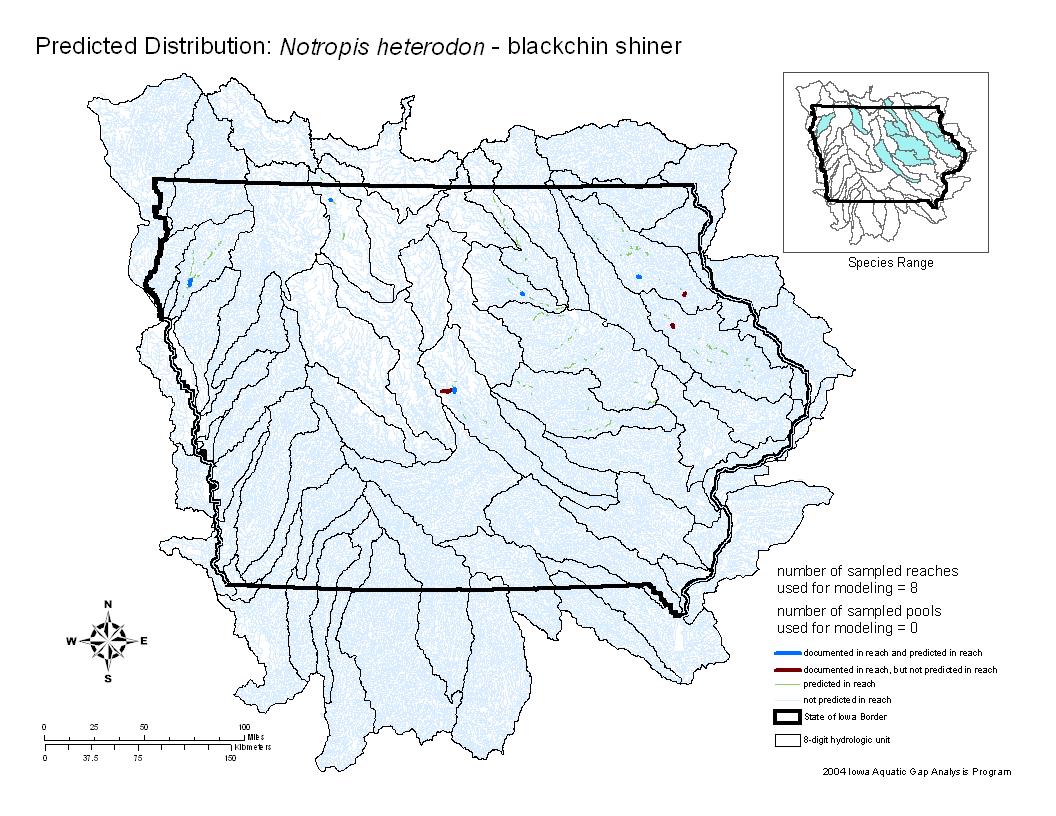Fish Iowa - Fish Species - Blackchin Shiner

Characteristics
This minnow has a stout, slender body. Olive-straw body, overlaid with silvery on the back, shading to silvery-white on the belly. A distinctive character is the prominent lateral band, which surrounds the snout and lower jaw giving rise to the common name. This band also passes through the eye and along the body to the caudal fin. The terminal mouth has an oblique angle and no barbell. Strongly hooked pharyngeal teeth, with well developed cutting edges, are arranged in a pattern of 1, 4-4, 1. Dorsal, anal and pelvic fins have 8 rays and the pectoral fins have 12-14 rays. The lateral line has 36 scales, but not all have pores. These are scales on the breast in front of the pectoral fins.
Foods
Aquatic insects and cladocera (zooplankton) at the water surface.
Expert Tip
Blackchin Shiners need clear, vegetated water over a sand bottom, and since this habitat is nonexistent in Iowa, this species no longer lives in Iowa.
Details
Blackchin Shiners prefer clear, well-vegetated water over a bottom of sand, gravel, or organic detritus, disappearing almost immediately when waters became turbid. This species is considered extirpated from Iowa because of a radically changed habitat. Having a northern range, the Blackshin Shiner is characteristic of the glacial lake district inhabiting shallow areas of glacial lakes, potholes and streams which are usually lake outlets or inlets.
Recent stream sampling has not resulted in the discovery of any individual Blackchin Shiners.
The Blackchin Shiner is viewed as extirpated according to the Iowa Wildlife Action Plan.
Sources:
Harlan, J.R., E.B. Speaker, and J. Mayhew. 1987. Iowa fish and fishing. Iowa Conservation Commission, Des Moines, Iowa. 323pp.
Iowa Department of Natural Resources, Iowa Wildlife Action Plan
Loan-Wilsey, A. K., C. L. Pierce, K. L. Kane, P. D. Brown and R. L. McNeely. 2005. The Iowa Aquatic Gap Analysis Project Final Report. Iowa Cooperative Fish and Wildlife Research Unit, Iowa State University, Ames.
Photo credit: Photo courtesy of Konrad P. Schmidt, copyright Konrad P. Schmidt.
Distribution Map

Fishing is not allowed for this species.
If you catch this species, immediately return it to the water with as little injury as possible.